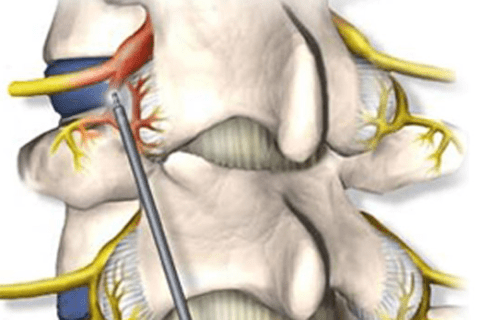RHIZOTOMY

RHIZOTOMY
RHIZOTOMY
If you are suffering from pain in the spine, especially due to the facet joints, a rhizotomy can help you eliminate pain and achieve long-lasting relief.
What is a Rhizotomy?
Rhizotomy is a surgical procedure to sever nerve roots in the spinal cord. The procedure effectively relieves chronic back pain and muscle spasms. For spinal joint pain, a facet rhizotomy may provide lasting low back pain relief by disabling the sensory nerve at the facet joint.
How is a Rhizotomy Performed?
The rhizotomy procedure, although surgical, is fairly simple. In fact, it is often performed using only local anesthetic. During the procedure, a small needle will be inserted into the nerves where pain signals are originating. Then, we will apply controlled radiofrequency energy to the nerves using this needle. This process heats and damages the nerves, preventing them from sending pain signals through the body. The rhizotomy treatment takes about an hour to perform.
What is Recovery Like After a Rhizotomy?
After a rhizotomy, patients are encouraged to take at least a day off of normal activities. Exercise, heavy lifting, and other strenuous activities should be avoided for at least a few days. You may notice some swelling, soreness or bruising in the treatment area, but these symptoms should fade shortly after treatment.
What Kind of Results Can I Achieve from a Rhizotomy?
After a rhizotomy, the nerves are no longer able to transmit pain signals to the brain. This means you should notice an improvement in your pain levels as soon as immediately after your procedure. The body heals itself over time, meaning that your nerves will regenerate and some pain may return. However, most patients enjoy the results from their rhizotomy treatment for a year or longer. The procedure can be repeated as needed.
-
What is a Rhizotomy?
Rhizotomy is a surgical procedure to sever nerve roots in the spinal cord. The procedure effectively relieves chronic back pain and muscle spasms. For spinal joint pain, a facet rhizotomy may provide lasting low back pain relief by disabling the sensory nerve at the facet joint.
-
How is a Rhizotomy Performed?
The rhizotomy procedure, although surgical, is fairly simple. In fact, it is often performed using only local anesthetic. During the procedure, a small needle will be inserted into the nerves where pain signals are originating. Then, we will apply controlled radiofrequency energy to the nerves using this needle. This process heats and damages the nerves, preventing them from sending pain signals through the body. The rhizotomy treatment takes about an hour to perform.
-
What is Recovery Like After a Rhizotomy?
After a rhizotomy, patients are encouraged to take at least a day off of normal activities. Exercise, heavy lifting, and other strenuous activities should be avoided for at least a few days. You may notice some swelling, soreness or bruising in the treatment area, but these symptoms should fade shortly after treatment.
-
What Kind of Results Can I Achieve from a Rhizotomy?
After a rhizotomy, the nerves are no longer able to transmit pain signals to the brain. This means you should notice an improvement in your pain levels as soon as immediately after your procedure. The body heals itself over time, meaning that your nerves will regenerate and some pain may return. However, most patients enjoy the results from their rhizotomy treatment for a year or longer. The procedure can be repeated as needed.







